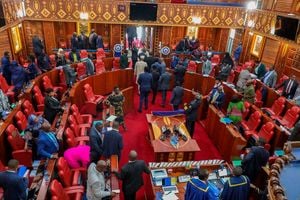Survey: UDA remains most popular party

Trends and Insights for Africa (Tifa) CEO Maggie Ireri addresses journalists while releasing the results of an opinion poll on the performance of the Kenya Kwanza administration at the Heron Portico Hotel in Nairobi in mid July.
President William Ruto’s UDA party has maintained its status as the most popular political party in the country, with its acceptance nearly double that of ODM, according to a recent opinion poll.
The survey shows that UDA enjoys the support of 35 per cent of Kenyans while ODM comes second at 16 per cent.
The opinion poll by Trends and Insight for Africa (Tifa) shows that the former ruling Jubilee Party now commands a mere 2 per cent of support countrywide.
The Wiper Democratic Movement enjoys 3 per cent of support while the other parties in the country have a total backing of 6 per cent.
The Tifa survey was conducted between September 8 and September 10 and involved 1,007 respondents from across the country. Its results were announced in Nairobi yesterday.
The survey further shows that UDA’s strongholds are in the Central Rift and Mt Kenya regions, reflecting the success the party enjoyed in those areas during last year’s General Election.
However, it is in the northern part of the country where there has been significant change. In late July 2022, a Tifa poll indicated that the combination of ODM and Jubilee enjoyed far much more popularity than UDA (51 per cent versus 31 per cent). The current poll reveals a remarkable reversal, with UDA now commanding twice the popularity of ODM in these regions.
“As for ODM, aside from Nyanza and South Rift, in the other four zones where it remains the most popular party, UDA is nipping at its heels,” the survey stated.
Further, a consistent trend of declining support was observed in both the ruling party and the primary opposition party, extending to the two main coalitions.
According to the survey, over the past three months, the ruling Kenya Kwanza Alliance has experienced a more significant loss of support compared to Azimio la Umoja One Kenya—from 49 per cent to 35 per cent and from 40 per cent to 28 per cent, respectively.
“These declines are reflected in the substantial increase in the proportion expressing support for neither coalition, nearly tripling since March (from 13 per cent to 36 per cent),” reads the survey.
“Despite holding strong majorities in both branches of the national legislature, the Kenya Kwanza government finds itself with the backing of less than half of the Kenyan population, with only 39 per cent expressing their support. Remarkably, this figure aligns with the percentage of Kenyans who prefer not to align themselves with any political party or coalition,” the states.
The survey further shows that while a relatively small minority of Kenyans express support for local-level political parties, accounting for approximately 17 per cent, this phenomenon is most prevalent in the Lower Eastern region. This trend is notably influenced by the fact that Wiper, the most popular local party in the area, did not field a presidential candidate in the 2022 poll.
On Jubilee leadership, more Kenyans identify Jeremiah Kioni as the party’s secretary-general (32 per cent) than Kanini Kega (21 per cent). Mr Kega enjoys more recognition among pro-government Kenyans while Mr Kioni enjoys more recognition among Azimio supporters.





